This is the last post in a series of posts about focal lengths in food photography. You can read more about 35mm, 50mm, 85mm & 105mm focal lengths
If you have a cropped sensor camera, lens and focal length advice is a little different for you. Let’s first cover what a cropped sensor is and then get into the two lenses I recommend using.
We have two types of cameras, full-frame and cropped sensor. The difference is that they have sized sensors. This affects how focal length appears due to the ‘cropped’ nature of the sensor.
RELATED: Full Frame vs Cropped Sensor Which Is Better for Food Photography?
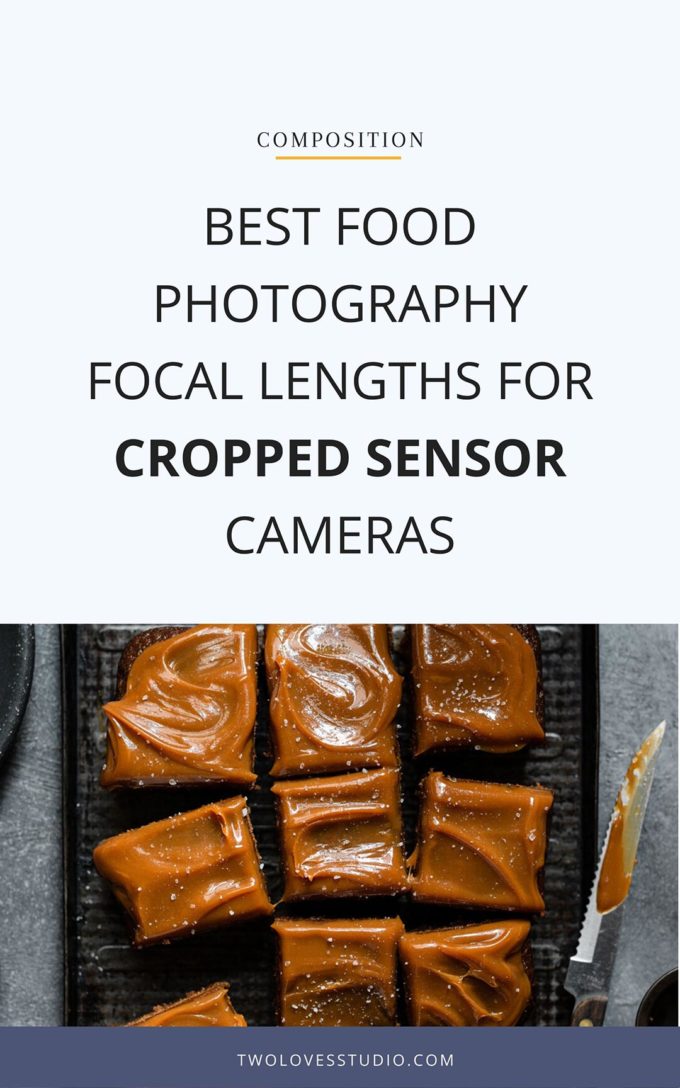
What is A Cropped Sensor Camera?
A cropped sensor is essentially a smaller sensor (than a full-frame) and gets its name from what is known as the ‘crop factor’.
There are different ‘crop factors’ in cropped sensor cameras.
It means that if you are shooting the same scene as someone who has a full-frame, your image is going to be ‘cropped’.
This means you’ll be able to fit less in the frame at the same distance. Let’s see this visually.
Each brand of camera has a different ‘crop value’, so lenses will look slightly different between brands.
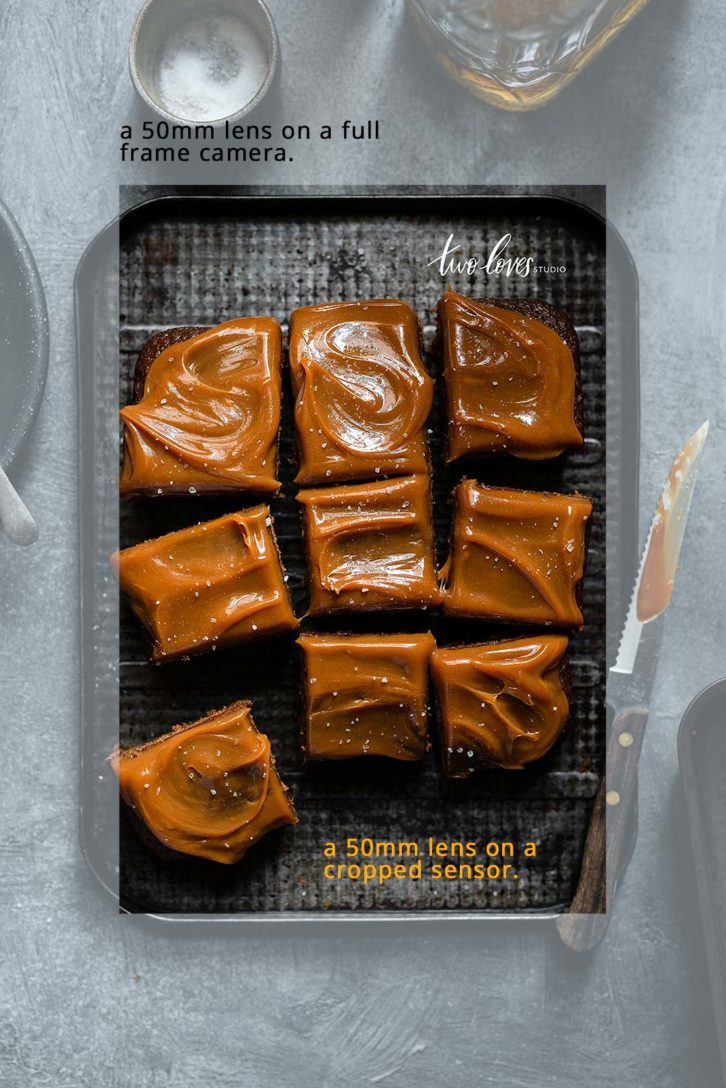
Lens Focal Length Advice is Different For Cropped Sensors
This ‘crop factor’ is the reason why lens advice is different for cropped sensor cameras.
Because cropped sensor cameras have a smaller sensor, the actual focal length won’t be the same as on a full-frame.
To make this easier, let’s look at some examples of focal lengths:
- 35mm = 52.5mm on a cropped sensor
- 50mm = 75mm on a cropped sensor
- 85mm = 127.5mm on a cropped sensor
- 105mm = 157.5mm on a cropped sensor
Now you can see from the above that the change in how focal length appears will change the lens advice.
As cropped sensor owners often get left out, I wanted to share the two focal lengths I recommend you look at getting for your food photography.
35mm For Flatlays & Overhead Shots
Firstly, this advice is based on the fact that you own a cropped sensor camera and don’t have plans to upgrade to a full-frame in the near future (or ever upgrade at all!)
The first recommendation for focal length for cropped sensor cameras is the 35mm.
On a cropped sensor, the 35mm will act like a 50mm focal length. This is good for overhead shots and flatlays.
If you ever did upgrade to a full-frame, it wouldn’t be a lens that you’d use much for food photography other than photographing restaurants. It’s also not a super cheap option, but if you take care of it, you can always sell it.
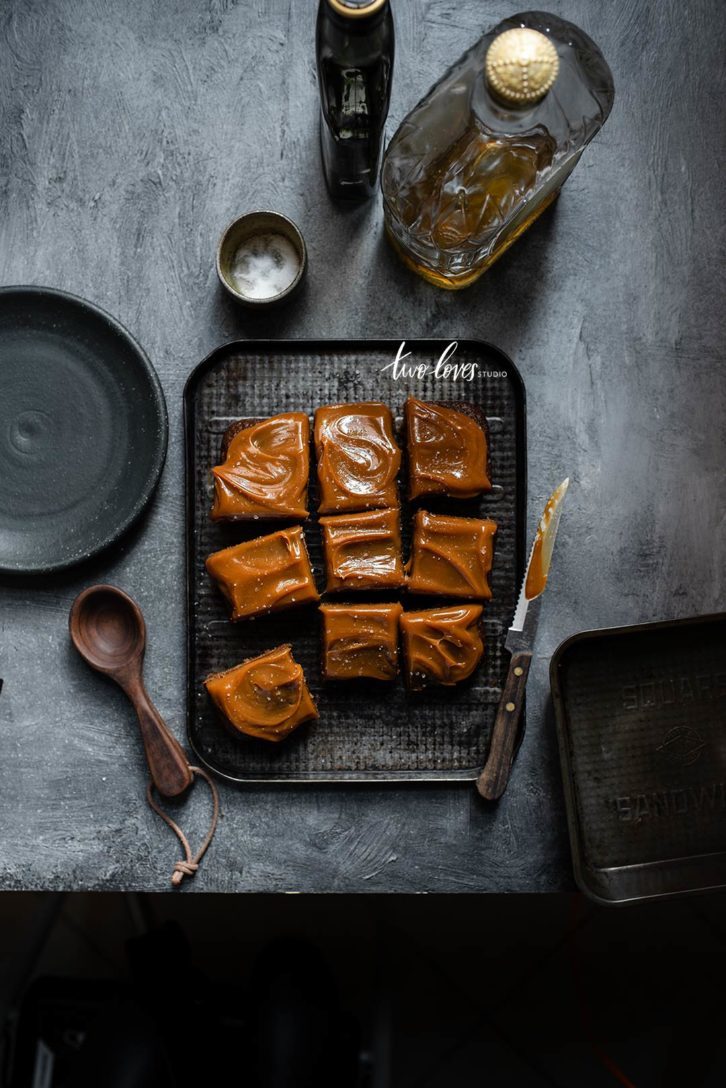
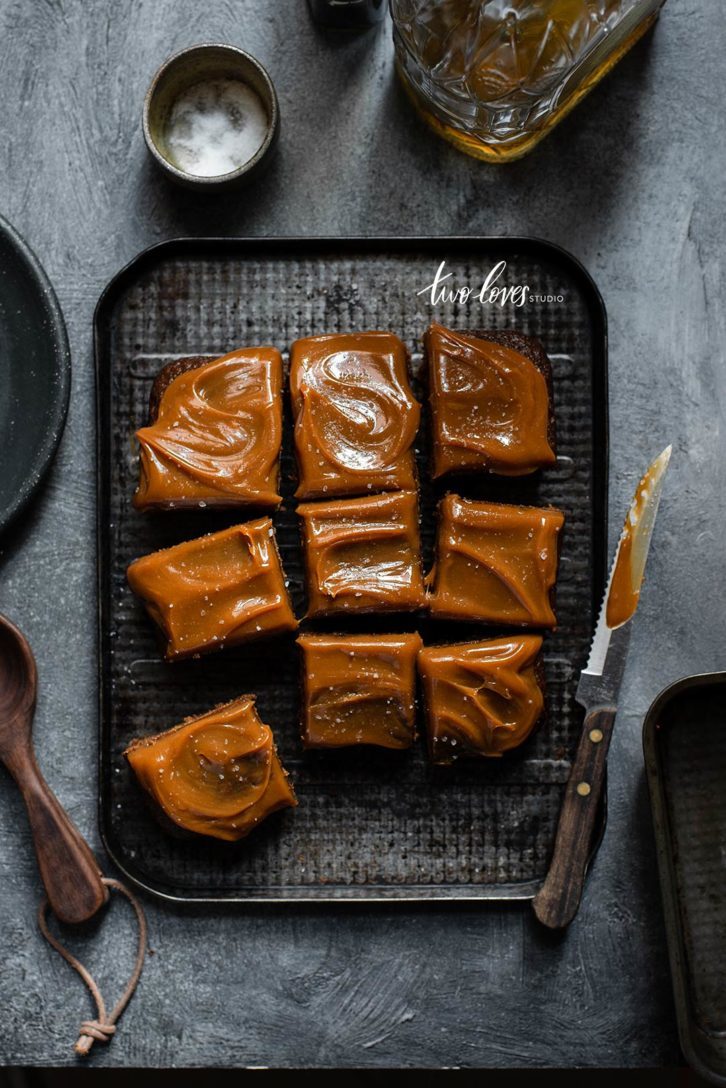
60mm For 45-degree Shots
The second recommendation is the 60mm. Now I am making a distinction between the 50mm and 60mm focal lengths.
With a 60mm, you are shooting at the equivalent of 90mm focal length (close to the 105mm focal length in this series). This focal length is great for 45-degree shots.
The reason I like to advise the 60mm over the 50mm is that the 60mm focal length comes in a macro lens.
That means you can get that great blur that complements the 45-degree shots. You’ll be able to get up close to your food and get those lovely macro food detail shots.
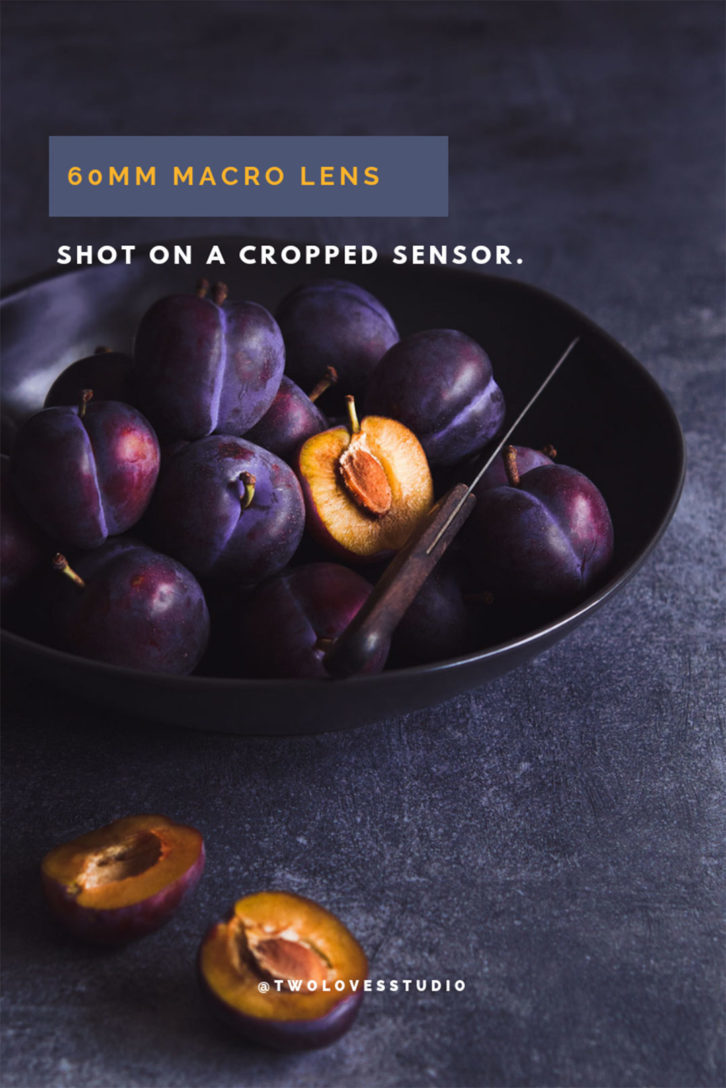
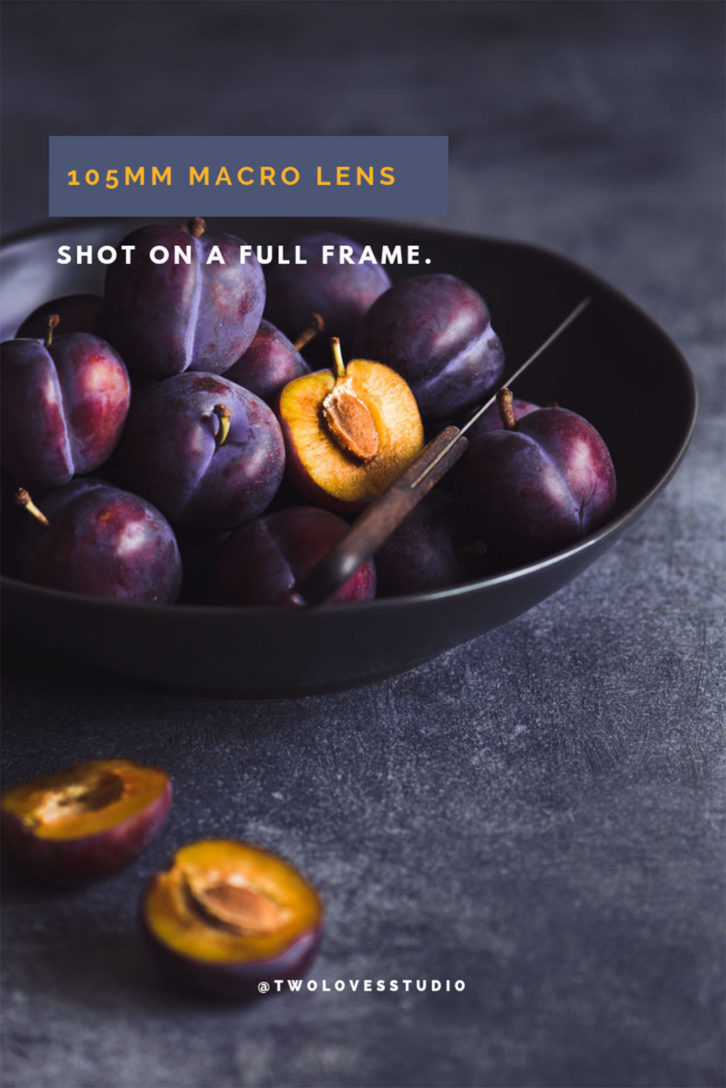
If you were only going to get two lenses for photographing food and you have a cropped sensor, these two focal lengths would be what I recommend.
Do you have a cropped sensor? Which lenses do you use the most?



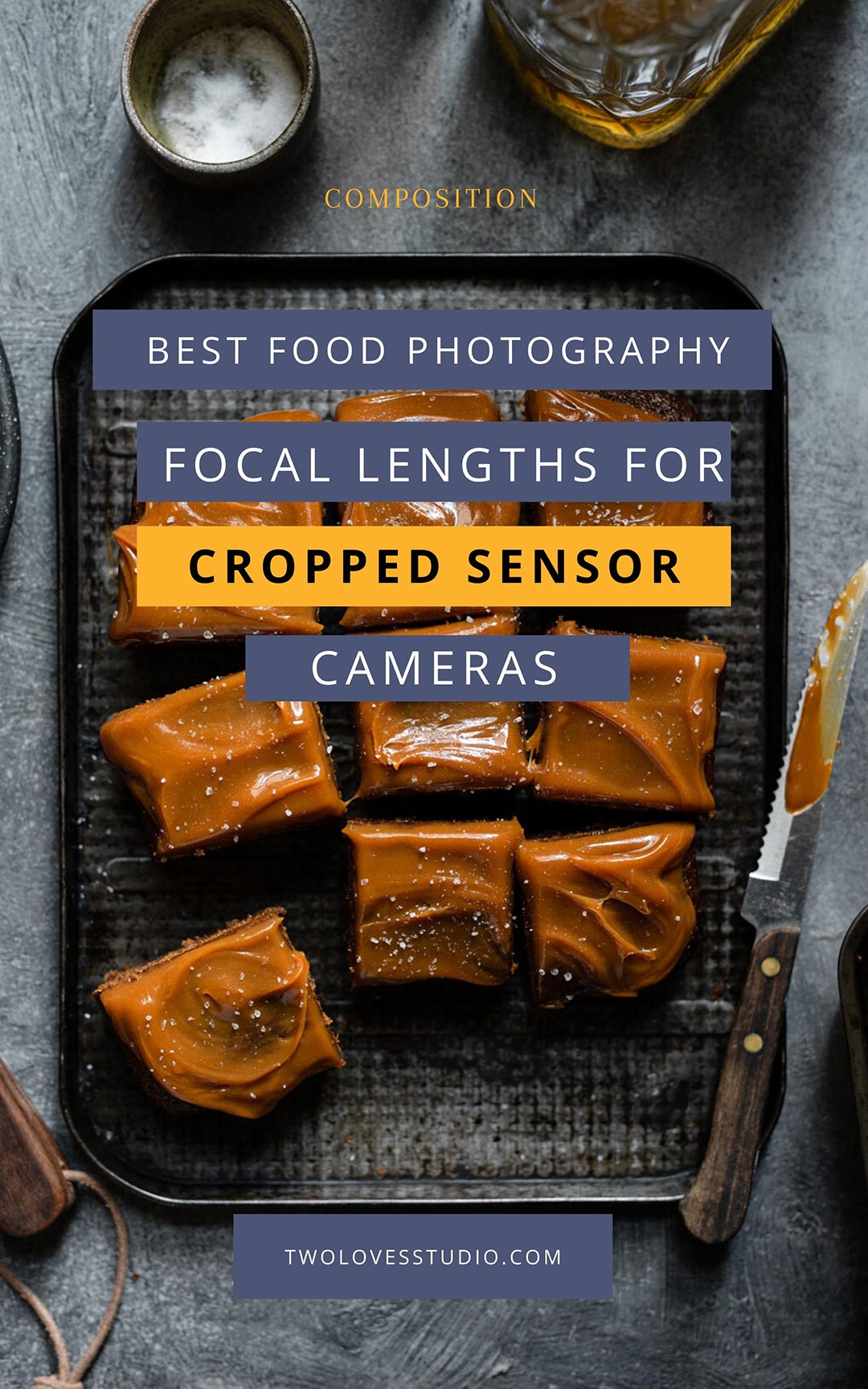
Christian
Hey Rachel,
Great series of articles on focal length! Very informative. Just one point I wanted to clarify; in all these articles, you are talking about prime lenses, correct?
What is your take on zoom lenses that can offer up several focal lengths in one lens?
Rachel
You’re welcome, Christian! So glad you enjoyed it. Focal length and lenses aren’t the same thing. They are separate concepts. So rather than talk about one specific lens, I wanted to talk about ‘generally’ what each focal length is good for. So rather a 35mm focal length on either type of lens is still good for the points in this article. Does that make sense?
Zoom lenses definitely offer up a number of focal lengths, which is why people love them. I am biased to primes. Primes tend to be sharper at the apertures I like to shoot at. I also think zoom lenses can make us creatively lazy. It’s a personal choice, so don’t feel compelled to agree with me. Here is a post I did on that if you are interested: https://twolovesstudio.com/blog/zoom-lens-killing-your-food-photography/
Gabriella
Hi Rachel! Thanks so much for this post. I own a crop sensor and while, I plan to upgrade to full-frame in the future, I am sticking with the crop for now.
I was wondering if you could help with the following question. I know there are lenses that are compatible with both crop and full frame sensors, (a 35mm on a crop is 50mm full frame, etc.) But I’m curious, are EF-S lenses designed in such a way that when it says 50mm, you are getting 50mm since they are specifically designed for crop sensors and will not be placed on a full-frame?
I know that is a little confusing so I hope that makes sense haha
Thanks so much!
Gabriella
Rachel
Totally makes sense Gabriella! You’ll always have to do the conversion when it comes to focal length and cropped sensor lenses. The ‘mm’ of the focal length will never be what you see on a cropped sensor, you’ll always have to do the conversion. I believe that all companies do it that way as a way to be standardised. You’ll always be looking for the ‘equivalent focal length’ on a cropped sensor/lens. The reason they have ‘full-frame’ and ‘cropped sensor’ lenses is that there are different components and materials needed to cover the size of the sensor. The smaller cropped sensor lenses need fewer materials and glass and therefore can be cheaper. But then you can’t use them on a full-frame. So if you’re looking to upgrade in the future, I always recommend buying a lens that will work with your full-frame. Does that help at all?
Gabriella
That all makes perfect sense!! Thank you so much for clearing that up =)
Rachel
Perfect! So glad to hear that.
Anna
Hey Rachel!
what an awesome series – thanks so much for this!
I do shoot a cropped sensor and I only wish I’d had your advice earlier. it makes so much more sense now.
Thank you & keep on doing what you do!
Anna
Rachel
Thanks Anna! So pumped to hear that you enjoyed it! Which focal lengths do you own?
Kim
Thank you. Your blogs all week have been so beneficial. Thanks for including us “cropped” creators!
– Kim
Rachel
I am so glad to hear you enjoyed it Kim and of course, happy to always help out cropped sensor uses. It can be so tricky to understand some of this some time!
Lyn Banks
Hi Rachel,
I really enjoy your series of articles as they demystify many potentially complicated subjects.
I have a cropped sensor camera and also a 35mm lens specifically for a cropped sensor. Is this still recommended for overhead and flatlays?
Based on your recommendation previously, I invested in a 60mm macro lens (90mm equivalent) and it is amazing!
Thanks so much 🙂
Rachel
Yay Lyn! I am so glad to hear that. Yes that’s correct. A 35mm will be more like a 50mm and will be great for overhead shots and capturing flatlays. So happy to hear you are loving the 60mm! x
elise
Hi Rachel! So I finally ended up commenting here, rather than bugging you on instagram 😉 Like Gabriela who commented above, I am now working with a cropped sensor and shooting mostly with my 35 mm. I am planning to upgrade as soon as I have some funds saved up, but since I just made the transition to full-time freelancing it’s hard to know how long that will take. So I’m wondering whether or not it would make sense to invest in a 60 mm macro first (a significantly smaller investment). I do own a 50 mm, but that’s not a macro obviously. Long story short, I guess my question is just: is a 60 mm macro a useful lens to combine with a full frame too (in terms of food photography)?
Rachel
So awesome to see you here Elise and first, congrats on full-time freelance! I get how important it is to make the budget we have stretch as far as we can! Once you get to full-frame, the 60mm won’t be able to do the same job as the 105mm (or 100mm if you shoot Canon). It’s not that it’s redundant to have the 60mm with a full-frame, it’s just I would recommend getting the 100-105mm first. It will be of better use to you. Especially since you have a 50mm. I always say to invest in the best lenses you can, as it will save you money in the long run. It is also important to get a good quality sensor, so saving to upgrade to the latest full-frame models is a good idea too. That leaves you with two options, save a little more for the 100-105mm (if you can), but if that’s not possible you could get the 90mm Tamron which I’ve heard nothing but good things (it will be cheaper than it’s Canon/Nikon counterparts). You could also look into a macro extender for your 50mm to tie you over until you get a full-frame. If you can, I always recommend renting some lenses before you buy! Let me know if that helps! xx
Fallon Brooks
Hey Rachel,
I read most of your articles and they are very informative. It’s like a mini photography school, I love it. I’m trying to upgrade from my Nikon D5300 18-55mm to a macro lens to take more professional photography and start doing videography. Unfortunately, I can’t get a smaller aperture or up close with my camera. Would you suggest I go for 85mm f/1.8 or 60mm macro or for a 105mm macro lens for both photos and videos?
Thanks
Rachel Korinek
Hey Fallon, so glad to hear that! I love talking about photography – clearly! The kit lens does have it’s limitations and sounds like you’re ready for something new! The lens I suggest will really depend on if you ever want to upgrade to a full-frame or not. Plus understanding ‘how close’ you want to be to your food. Macro photography is great for food, but you also want to be able to capture a food scene. For these reasons, you’ll usually need more than one lens when it isn’t a zoom lens. There isn’t zoom lenses that are also macro lenses (that I am aware of at the time of writing this). The 85mm is a great lens, but its minimum focusing distance won’t allow you to get close to food. I don’t recommend this lens for you at this stage based on what you need. The 105mm is amazing but is going to be very tight on a cropped sensor. I would recommend you get a 60mm macro if you want to get closer to food and then use your kit lens 18-55mm to set it to 35mm (50 equivalent) for wider food scenes. I always recommend renting a new lens when you can so you can test it out before you buy!
Valeria Suppa
Hi Rachel, great article indeed! I have a cropped sensor camera and a 50mm lens, but I find it hard to shoot flat lays, especially when I want to portrait my hands working on a table (and anyway to have my set at a window’s level). Do you think a 35mm would be short enough for this purpose? Thanks
Rachel Korinek
Hi Valeria! So glad you found it helpful! Yes absolutely. The 35mm on a cropped sensor is a 50mm equivalent so it’s much better for flatlays especially when your set is at window height. If you do more to full-frame though, the 35mm isn’t a lens that you will use as often in food. So there is a trade-off there. I wrote a post on when to use the 35mm (on a full-frame so it’s true 35mm), so you can get a sense of how you would use it if you did upgrade.
Swadhinata Saha
Hi Rachel, it was so informative to read your article. Thanks for considering us who already have a crop sensor camera. Now I have a 50 mm (f 1.8) and 35 mm (f2.8) lens. Can I use my 50 mm for macro or for a bokey effect as I am little short of budget right now to buy 60 mm ? Thanks in advance.
Rachel Korinek
You sure can, it’s just going to come down to your aperture and the distance that your subject is from the camera. If you shoot at f/1.8 – f/2 somewhat close to your subject, you’ll be able to get this effect. Heres’s a post I wrote on this subject: https://twolovesstudio.com/blog/blur-background-food-photography/
Carlos at Spoonabilities
Hi Rachel, Thank you for sharing your knowledge and helping others to understand the different aspects of food photography. I have a question, and probably I should have seen the answer in your different posts, but I’m still a bit confused, and I would love for you to help me with some clarification.
I have a cropped sensor Canon camera. The lens: EF-S60mm, EF-50mm, and the kit lens that came with the camera 18.55mm.
I’m looking to purchase a new lens because I sometimes love to take overhead photos capturing a wide tabletop photo. I find with the 50mm, I have to put my C-stand all the way to the top, but I still don’t feel that I get enough table space. When I use the kit lens to get the wide-angle, the object/food looks too far.
I would like to know what specific lens do you recommend for me. I still have the basic camera, and I’m not planning to upgrade to a full-frame for right now. This is the camera model that I own: Canon EAS Digital Rebel SL1 W/18-55MM.
I will truly appreciate your help with the recommendation. Thank you,
Rachel Korinek
Hey Carlos! You’re so welcome. Thanks for your question. I would recommend the 35mm for you on a cropped sensor. That will help you take the wider table scene shots you’re after. The 35mm on a cropped sensor is more like a 50mm (equivalent) which is great for flatlays. If you have the 18-55mm kit lens, you already have access to the 35mm focal length. So you can test it out to see if you like it. The benefit of getting a 35mm (Canon or Sigma) is that you will have access to wider apertures or light and creative blur. I would say if you are planning on upgrading soon, save your budget for your camera and use your kit lens at 35mm, but if you’re not going to upgrade, then look into a 35mm 🙂
Maya
Hi Rachel,
Thank you for another amazing article! I only wish I found it before buying my first (cropped lens) camera and 50mm lens. I spent a month trying to figure out why “the nifty fifty” wasn’t all that nifty for me before finding this article today. One question- if I could only invest in one lens right now for my cropped camera, would the 35mm make most sense as a versatile option for a beginner food photographer shooting both flat lays and 45 degree shots?
Thank you again!
Rachel Korinek
Hi Maya, thanks for sharing that with me. I wish you had found this article too. I wrote it because I wanted to share the best advice for food photographers. Unfortunately, with photography, there isn’t always one lens that fits every single need we have. So it will come down to how you like to shoot. For overhead, I recommend 35mm. For 45-degree, I recommend 60mm. So I think the best thing to do is think about the shots you want to capture. If you want larger flatlays mostly, the 35mm is best. If you like tighter 25-75 degree angles then the 60mm. I know that’s probably not the exact answer you were hoping for, but hopefully, this helps you decide. Let me know if you have any follow up questions.
Karen
Hi Rachel!
Sorry if this question is too shallow but I’ve been wondering.
These lenses that you recommend, can these also be used for food videography?
What focal length would you recommend most for shooting cooking videos, recipe tutorials, homebaking videos, etc?
Rachel Korinek
Hey Karen! Every question is a good one! I don’t shoot video (at the time of writing) so I don’t feel I an adequately answer this question for you — my apologies! If you want to see the lenses I have and how I use them for food photography, you can check out this post: https://twolovesstudio.com/blog/professional-food-photography-lenses/.
Tamron India
Thanks for the post, Introducing Tamron’s Best Zoom lens, designed specifically to meet the needs of professional photographers. With its advanced and innovative technology, this lens ensures crisp and clear images, making every shot a masterpiece. Plus, its compact and lightweight design lets you capture those breathtaking moments without any hassle. Get ready to elevate your photography game with Tamron’s Best Zoom lens.
Visit here: https://tamron.in/
Tamron India
Tamron India presents a remarkable range of DSLR camera lenses that cater to the diverse needs of photography enthusiasts. Our lenses are designed using cutting-edge technology and high-quality materials to deliver exceptional performance. Whether you are an amateur or a professional photographer, our lenses will help you click sharp and clear pictures, every time.
Visit here: Tamron India presents a remarkable range of DSLR camera lenses that cater to the diverse needs of photography enthusiasts. Our lenses are designed using cutting-edge technology and high-quality materials to deliver exceptional performance. Whether you are an amateur or a professional photographer, our lenses will help you click sharp and clear pictures, every time.
Visit here: https://tamron.in/
Win Pkr
This was an incredibly helpful post! I never realized how much the focal length can impact food photography, especially with a cropped sensor. The examples you provided really clarified which lenses to consider. Thanks for sharing such valuable insights!
WinPKR app
WinPKR app is the ideal choice for Android users who are looking for a blend of entertainment, social interaction, and the chance to win exciting prizes.
YOUTUBE MUSIC PREMIUM APK
Great insights! I never realized how much the focal length could affect food photography on cropped sensor cameras. Your examples really helped clarify what to look for. I’m excited to try some of these suggestions in my next shoot!
sss tik
Great insights on focal lengths for cropped sensor cameras! I always struggled with choosing the right lens for food photography, but your recommendations have clarified a lot for me. Can’t wait to put them into practice!
Daniel Fox
Focal lengths do not change on smaller formats – only angle of view.
Focal lengths (like aperture is a fixed characteristic of a lens).
Focal length is measured from the point on convergence inside the lens to the sensor.
Focal lengths are used to measure MAGNIFICATION – not width of shot.
So a 50mm designed for FF/135 mounted on an APSC camera – is still a 50mm lens, it simply has a narrower angle of view.
A 50mm on FF/135 gives you a 40 degree horizontal angle of view.
A 50mm on APSC gives you a 28 degree horizontal angle of view.
A 50mm lens designed for FF/135 projects a larger image circle than a 50mm lens made for APSC.
The focal length on the side of a lens made for APSC is exactly correct.
The difference is simple – on APSC you need to use lenses 1.5x wider (compared to FF/135) for the same angle of view.
So if you’re used to the angle of view a 50mm gives you on FF/135, you need to use a 35mm on APSC.